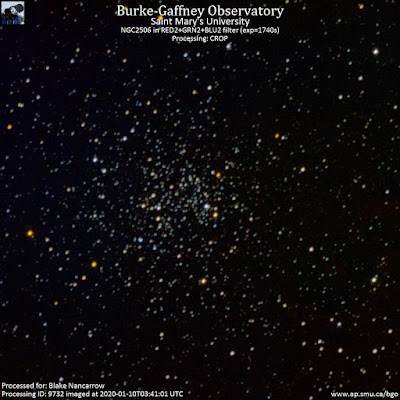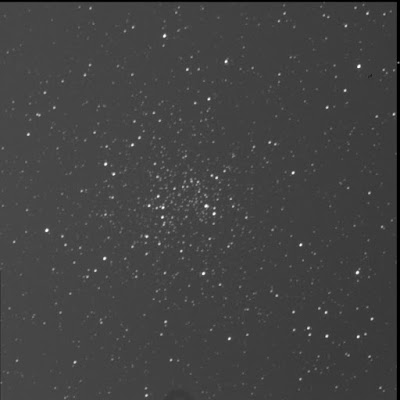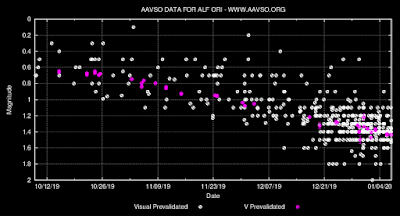Headed out back with all the gear. Big metal tripod with hex plate. Barn door tracker with alt-az base in box with controller and polar finding sheet. Camera with kit 18-55 lens but no battery grip so to reduce bulk and weight. I had previously installed the DC coupler. TV table and astronomer chair. Big gauge extension cord and GFCI power bar. Bits and bops (flashlight, weather station, eyeglasses straps, red eyeglasses, red keyboard light) in a carry-all.
Fired up the catalytic hand warmer. Took two tries with a candle. Worked well despite the old fuel. Toasty! It is awesome. Lots of layers, of course. Winter coat. New thematically appropriate constellations hoodie (though not a human could see it)! Maybe for the first time, three layers on the legs: underwear, pyjamas, and baggy jeans. My delicious -100 boots!
Forgot the netbook and wireless mouse on the first run.
Moon, crescent, just above the western trees; Venus, falling, warming, tangled in the branches.
Considered a light shield, to block the annoying street light from Frederick. Nothing available...
Hooked everything up. Very quick tripod and BDT setup. Did not sight Polaris... I know!
Tonight, I decided to try the in-camera noise reduction dark removal. Alan Dyer does it.
Started imaging tests using the Canon EOS Utility. Just on auto-pilot. Gave up during focusing trials when I couldn't see anything in the live view.
Fetched dew heating equipment. Cup warmer heater with custom cord, Kendrick controller, NOCO lithium battery with custom CLA adapter. Later my custom nichrome wire wrap. The cup warmer heater is too long with the lens at 18mm, cutting into the frame, visible.
Took the sky filter off the lens.
9:20 PM. Started using Backyard EOS. Frame and focus. 30 second shot.
The focus controls didn't seem to be working... Manually focused! [ed: Dew strap stiction?]
Beep-boop. Histogram looked OK. At 100% zoom level the focus looked OK. Stars looked round! Huh.
Couldn't remember how to zoom in with the app! The quick buttons in the interface are "fit" or 100%. And when combined with full screen, it helped. Had to dig around in the documentation... I was over-analysing it. Don't use the Ctrl key. [ed: Oops. Total forgot about my discovery in
May 2017!]
Really wanted Pleiades in the frame. Couldn't angle the camera at the pitch necessary given the ball head, and the hollow. Just the way it's designed. In a normal terrestrial application it would be fine, the camera could be pivot from horizontal to vertical, 90°, straight up. But my straight-up was 45° (more or less), whatever my latitude was.
Checked the settings, lens at f/5.6, body at ISO 800, RAW format, power level OK. Too bad BYE doesn't indicate AC power input rather than just a full battery. Was happy overall, so ordered a 12 of the images.
The battery looked weak for the deep red flashlight.
9:28. Checked the Oregon Scientific portable weather station: 42% relative humidity, air temperature -10.5°C. No wind... Moon was down, of course.
The estimated finished time looked wonky. Oh. Then it corrected itself. The app appears to initially calculate it at the beginning of the run. 2 minutes from the start? No. Now 9:38, 13 minutes from now. Right. 12 shots at 30 seconds would be 6 minutes times 2 for the darks would be 12 minutes total. Looked OK.
Zoomed in to a very high level. The focus was maybe off a little. Whatever.
Amazingly, the stars looked round. And I had not done a polar alignment, in any formal way. I just plunked down the tripod and mounted the BDT, aimed over the roof. That was it. I must have gotten very close... Lucky.
Noted the title bar in BYE: 3.1.16. Wondered if there was a new version.
9:34. Wondered how to get Pleiades... Couldn't tilt any more. Flip it?
I was feeling some time pressure. Chris had said the conditions were to change. My quick glance at the predictive sights show clouds rolling in after midnight. No clouds visible now. Skies looked really good!
(Bet that were having fun on Glen Major...)
Two more shots. At 11 of 12.
9:40. Inverted the camera! But, as I suspected, it created a balance problem. The altitude-azimuth base of the BDT wanted to flop open. The current rubber band (bands?) was weak and/or broken.
Adjusted the BDT alt-az. I put Polaris in the field of view of the finder (but not in the centre). It wasn't there at first but remarkably I was getting no visible trailing. Presumably it would be even better now. That said, I hadn't done co-axial tests...
Went inside for a big elastic. Amazingly, I found one! One centimetre wide band, strong, good condition.
Samsung, f/1.9, 1/25th, ISO 200, 4mm (27). The Up Side Down!
Tried a test shot in the new configuration.
Learned if you roll back the number of exposures in the BYE imaging sequence and it goes to zero (which by itself is odd), it clears the camera settings!
9:54. Image downloaded. Histogram looked good. Hit the 180 button in BYE. Got the Pleiades, but just barely. Turned the camera a bit more. Another test shot. Rotated some more.
Camera temperature was reporting at -6. Wow.
Nice framing! Checked focus—it was fair, not perfect. Programmed 12 shots.
10:00 PM. Saw the bug in the estimated finished time again. Not 2 minutes from now; should be 12. After first shot, waited for the noise reduction, downloaded, paused. As it started the second image capture, the estimate recalculated. Due around 10:13.
Went inside to ask Rhonda a favour. She let me use her Samsung smartphone camera (SM-a520w) with flash so I could take some set-up shots.
Samsung, f/1.9, 1/33th, ISO 160, 4mm (27). Frozen dew. Elastics everywhere. Big rubber band holding the motor plate down.
10:09. Checked an image. Framing looked good. Histogram looked OK, although fewer light pixels [ed: Less Newmarket light pollution while aimed to the south-east.] Camera temp was now -2, from -6, showing it was warming in the shooting process.
10:11. Worked on image 9 of 12. Backyard conditions: 42%, -11.7, precipitation tomorrow, air pressure dropping. Low humidity but we must have been at the dew point.
Discovered I forgot to cap the BDT finder. Oops.
Two to go. Stars didn't seem as bright. I wondered if the lens was fogging.
Started packing up. Stoopid neighbour's dog started freakin' out. Lame.
Beep-boop. Lens was fine. Capped everything. Bagged the camera.
Shot set-up photos.
Samsung, f/1.9, 1/17th, ISO 1250, 4mm (27). My workstation among the Baffin Island boot tracks and bunny hoof prints. That's not a star; it's the ridiculous street light from a block away.
10:25. On the move.




















